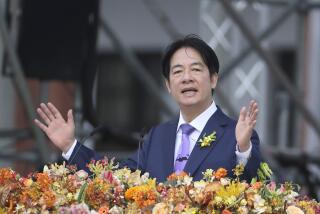Taiwan’s Fate Is Final Act of China’s Civil War
- Share via
MADISON, WIS. — China has again begun testing its growing arsenal of missiles off the northern and southern coasts of Taiwan. Ever since the first round of missile tests last summer--to protest the American visit of Taiwanese President Lee Teng-hui--Sino-U.S. relations have grown increasingly hostile.
These new tests will, no doubt, intensify hostilities. Congressional leaders will call ever more loudly for Washington to prepare for the military defense of Taiwan from communist attack. Commentators speculate ever more chillingly about a new cold war--and possibly a hot one.
Taiwan has been the major source of tension between the United States and China for nearly half a century. But there is little in Taiwan’s history, and even less in international law, to support the case for the island’s independence.
Except for aboriginal groups, usually assumed to be of Layan origin, Taiwan does not appear in historical records until the 15th or 16th centuries--when it was used as a base by pirates and traders from China, Japan, Portugal and the Netherlands. In the mid-17th century, in an uncanny dress rehearsal for a drama played out in the mid-20th century, Taiwan became the last bastion of the defeated Ming dynasty. The dynasty’s final military defender, the romantic pirate-adventurer Koxinga, fled the mainland and, after ousting the Dutch, established his rule over the island.
Koxinga’s descendants were, in turn, removed by the victorious Qing dynasty, in 1683. Taiwan was incorporated into the Chinese empire and administered as a prefecture of Fujian province for the next two centuries.
Significant migration from the mainland did not begin until the 18th and 19th centuries. Most of the migrants were from the coastal provinces of Fujian and Guangdon, the ancestors of those now called “native Taiwanese.” Ethnically, linguistically and culturally, they are no more distinctive than the various peoples who live in provinces on the mainland they originally came from.
One major turning point in modern Taiwanese history came when the decaying Qing regime was defeated by a modernizing Japan in the war of 1894-95. As war booty, Tokyo demanded Taiwan and the Pescadores. Taiwan was turned into a Japanese colony and remained so for a half century--until the end of World War II. Though Japanese colonial rule in Taiwan was not nearly as brutal as in Korea (colonized in 1910), the colonial government was essentially a military regime that suppressed all dissent and exploited the region for the benefit of imperial Japan. Some 300,000 Japanese immigrants held all significant government offices as well as the more lucrative positions in commerce, industry and the professions.
After the defeat of Japan in 1945, Taiwan was returned to China--then under the rule of Chiang Kai-shek’s Nationalist regime. All nations, including the United States, unquestionably assumed Taiwan was an integral part of China that had been unjustly colonized by an aggressor state. That assumption was shared by most Taiwanese at the time. By all accounts, Nationalist troops and officials were greeted as liberators in 1945
But the Kuomintang regime, grown corrupt and brutal during the war, was less interested in liberating the Taiwanese than in exploiting them for the benefit of the mainland--and “cleansing” them of what they said were Japanese cultural corruptions. A repressive military government was established; key commercial and industrial enterprises were nationalized for the benefit of the KMT elite; movable capital assets and rice were sent to the mainland.
The Taiwanese revolted against their new masters on Feb. 28, 1947. The “2/28” uprising was put down with great violence. More than 10,000 Taiwanese were killed by Nationalist troops--who used the occasion to liquidate much of the Taiwanese middle-class leadership. The slaughter ensured that, when the remnants of Chiang’s defeated army and bureaucracy fled to Taiwan two years later--making for about 2 million “mainlanders” in all--they would be faced with the bitter hostility of the 10 million “native Taiwanese.”
The Nationalist Party’s rule in Taiwan would probably have been short-lived had it not been for the outbreak of the Korean War, in June, 1950. That gave President Harry S. Truman the fortuitous pretext to order the “neutralizing” of the Taiwan Straits--making the Chiang regime dependent on the Seventh Fleet, and making Taiwan a de facto U.S. military protectorate.
U.S. military and economic support for the Nationalist regime was not entirely motivated by democratic ideals. In the 1950s and ‘60s, Chiang presided over a tightly run totalitarian state--probably more effectively totalitarian than the Chinese Communist government at the time. The KMT, after all, had a relatively large army and myriad secret police agencies in a relatively small territory--Taiwan is about 1/260th the size of mainland China. However, the Nationalist Party never claimed to be the ruler of Taiwan, but instead presented itself as the legitimate government of all China. That, after all, was its raison d’etre.
The KMT dictatorship began to be undermined in the 1970s--partly because of its own economic success; partly because generational changes began to blunt sharp distinctions between Taiwanese and mainlander, and partly because of the new U.S. policy normalizing relations with China in 1971. Taiwan was an internal Chinese matter, the 1972 Shanghai communique recognized, and U.S. military forces would be withdrawn from the island.
Propelled by these factors, a quasi-democratic political system evolved in Taiwan after the 1988 death of Chiang Ching-kuo, Chiang Kai-shek’s son and successor. Three major political parties have emerged to compete in Taiwan’s first direct presidential election, scheduled for later this month: the Democratic Progressive Party, which advocates Taiwanese independence; the ruling KMT, whose leader, Lee, serves as head of an independent nation-state while maintaining a verbal adherence to the party’s traditional goal of reunification with the mainland, and the New Party (made up of old-line KMT members and an assortment of younger people unhappy with Lee) which seeks some accommodation with the mainland.
After examining Taiwan’s history, it seems clear there is no overwhelming historical argument for an independent Taiwan. Perhaps the most compelling case for independence derives from the half-century of Japanese colonial rule. That, it might be argued, separated the Taiwanese people from the crucial political and intellectual developments that went into the making of the modern Chinese nation and created a distinctive Taiwanese identity. But such an argument can hardly be made by the ruling Kuomintang--whose Taiwanese leader still sponsors monthly lectures in honor of Sun Yat-sen, the “father of the nation.”
Indeed, with the powerful forces of Chinese nationalism at work in Taiwan (and the mainland), as well as China’s growing military power in the western Pacific, long-term prospects for an independent Taiwan seem dim. What appears possible is a significant degree of Taiwanese political and economic autonomy within the framework of a greater China--based on a recognition of Taiwan’s distinctive 20th-century history.
Such an arrangement can only be worked out by the various Chinese parties themselves. A real and durable autonomy will be less likely to come about if the U.S. government, driven by domestic political passions rather than realistic considerations of national interest, becomes involved in this final chapter of the Chinese civil war.
More to Read
Sign up for Essential California
The most important California stories and recommendations in your inbox every morning.
You may occasionally receive promotional content from the Los Angeles Times.










